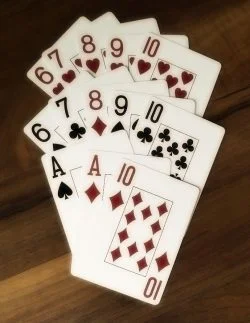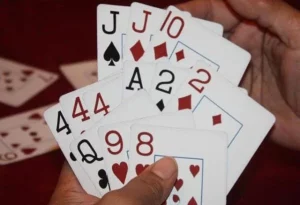Chinese Poker
In Chinese poker, players are dealt 13 cards each, creating opportunities for high-stakes decision-making and competition. Unlike traditional poker games where players compete against each other individually, Chinese poker usually involves four players. However, if there are less than four players, the remaining cards are simply discarded from the deck after each player has received their first 13 cards.
Here, we will cover the basics of Chinese poker and provide you with all the knowledge you need to immerse yourself in this exciting and challenging game. We cover everything you need to know to become an experienced Chinese poker player, from understanding hand rankings to mastering the tactics of the game.
How to Play Chinese Poker
Chinese poker is a variation of the traditional game that offers players a unique experience. Unlike other types of poker, Chinese poker has no ante, streets or blinds, making it a simpler and more straightforward game. Instead, the essence of Chinese poker is to create the strongest possible hands from a set of 13 cards in order to beat your opponents.
The basic rules of Chinese poker

- Setup: Chinese poker is usually played by four players, although there are variants for two or three players as well. A standard deck of 52 cards is used, with jokers acting as wild cards.
- Deal: At the beginning of the game, each player is dealt 13 cards from the deck face down. Players then deal these cards into three separate hands: a three-card front hand, a five-card middle hand, and a five-card back hand.
- Hand Ranking: Hands are ranked according to the standard poker classification: the strongest hand is the back hand, then the middle hand, and finally the front hand. However, there is a catch – each hand must be weaker than the hand behind it. For example, if you have a straight on the back hand, the middle hand cannot be a flush or better.
- Scoring: In Chinese poker, scoring is done according to a system agreed upon before the game begins. Generally, players receive one point for winning the first hand, two points for winning the middle hand, and three points for winning the back hand. In addition, bonus points may be awarded for certain bonus hands, such as a straight or flush in the back hand.
- Hand Deal: With the cards dealt into front, middle and back hands, players reveal their hands and compare them to their opponents’ hands. If a player’s hands are stronger than their opponents’ hands in all three positions, they win the game. If a player has a stronger hand in only one or two positions, he wins that position but loses the others, resulting in a tie or a division of points.
- Jokers: In some varieties of Chinese poker, jokers can be used as wild cards, replacing any other card in the hand. However, the use of jokers can affect the scoring system and hand ranking, so it is important to clarify the rules before playing.
- Hand distribution: After all players have dealt their hands, they reveal their hands to each other and the hands are compared. If a player’s hand is superior to their opponents’ hands in all three positions, they win the game. However, if a player has a stronger hand in only one or two positions, he wins that position but loses the others, resulting in a tie or a division of points.
How to Count Points in Chinese Poker
Scoring in Chinese poker is fundamental to the dynamics of the game, determining how players earn points and ultimately determining the winner. The scoring system is simple and is based on the results of each player’s front, middle and back hands.

In Chinese poker, players receive 1 point for winning the front hand, 2 points for the middle hand and 3 points for the back hand. This basic structure forms the basis of scoring, and bonus points are sometimes awarded for reaching premium hands such as straight or flush.
Once players have laid out their 13 cards into three separate hands, they reveal them to each other for comparison. The hands are then ranked according to standard poker hand rankings: the back hand is weighted the most, followed by the middle hand and the front hand.
If a player’s hand is superior to his opponents’ hands in all three positions, he wins a complete victory, receiving points for each hand won. If, however, a player has a stronger hand in only one or two positions, he wins those positions but may lose the others, resulting in a tie or a division of points.
Throughout the game, players accumulate points based on the outcome of each hand. These points are tallied at the end of each round or game, determining the overall winner by the highest number of points.
How to Choose the Right Hands When Playing Chinese Poker
Choosing the right hands is the most important aspect of playing Chinese poker effectively. By adhering to certain rules and strategies, players can improve their skills and increase their chances of success at the tables.
- Understanding Hand Strength: The first rule of thumb when choosing hands is to understand hand strength and how it applies in Chinese poker. Generally, hands with higher ranked cards have more potential to win in the back hand, while hands with lower ranked cards are preferred for the front hand. However, it is important to find a balance between strength and consistency in all three hands.
- Maximize the strength of the back hand: Since the back hand contributes the most points to a player’s score, prioritizing its strength is crucial. Strive to build as strong a back hand as possible, focusing on high-ranking combinations such as straights, flushes, and full houses whenever possible.
- Balance the middle and forehand: While the backhand is paramount, neglecting the middle and forehand can be detrimental to overall performance. Use the middle hand to complement the back hand, aiming for strong combinations such as three of a kind or two pair. For the front hand, prioritize consistency and stability by choosing low rank cards and avoiding high cards that can disrupt the hand hierarchy.
- Avoid dead cards: Dead cards – those that are unlikely to improve any of your hands – are best avoided whenever possible. Pay attention to cards that have already been played or are visible on the table, and adjust your hand selection accordingly to maximize the chances of improvement.
- Adapting to your opponents: Understanding your opponents’ playing styles and tendencies can help you with your hand selection strategy. If you notice that your opponent often plays aggressively or conservatively, adjust your hand selection accordingly to exploit his weaknesses and capitalize on favorable situations.
- Evaluating Draw Potential: When selecting hands, consider their draw potential. Hands with the potential to improve by drawing additional cards can be advantageous, especially if they have a strong potential to strengthen the middle or back hand.
- Risk Management: Be careful when selecting high-risk hands that rely heavily on drawing extra cards. While these hands can offer the potential for significant improvement, they also carry a high degree of uncertainty and can backfire if drawing opportunities are not realized.
By following these rules and strategies for hand selection in Chinese poker, you can improve your skills and increase your chances of success at the tables. Remember to find a balance between hand strength, consistency and adaptability, and constantly improve your hand selection strategy with practice and experience.
Example of Card Counting in Chinese Poker
In Chinese poker, hand strength is determined using a unique card counting system that differs from traditional varieties of poker. Instead of focusing solely on hand rankings, Chinese poker uses a scoring system based on the relative strength of the hands in each position – front, middle and back.
Let’s take an example of how card counting works in Chinese poker:
Imagine you have been dealt the following 13-card hand:
- Front Hand: 8♠ 7♦ 4♣
- Middle Hand: Q♠ Q♦ J♣ 9♥ 2♠
- Back hand: A♠ K♦ 10♣ 6♥ 5♠
Now let’s sort these cards into hands and assign points based on their strength:
- Front Hand: The front hand consists of 8♠ 7♦ 7♦ 4♣, which forms a relatively weak hand. In Chinese poker, the front hand is usually evaluated by the highest card. Since the highest card in this hand is an 8, it gets 8 points.
- Middle Hand: The middle hand consists of Q♠ Q♦ J♣ 9♥ 2♠, which includes a pair of queens. In Chinese poker, pairs are strong in the middle hand. Therefore, this hand earns points based on the strength of the pair – in this case a queen, which is worth 8 points each, totaling 16 points for the middle hand.
- Back Hand: The back hand consists of A♠ K♦ 10♣ 6♥ 5♠, forming a potential straight with senior cards. Straights and flushes are strong in the reverse hand, so this hand earns points based on the highest straight card, in this case an ace, which is worth 13 points.
After awarding points to each hand, we calculate the total points to determine the overall strength of the hand. In this example, the total points for the hand would be 8 (front hand) + 16 (middle hand) + 13 (back hand) = 37 points.
Peculiarities of Chinese Poker Rules
Chinese poker offers many variations in gameplay and rule variations, allowing players to customize their preferences. One notable aspect of the game is the flexibility of combinations and rules, which can greatly affect the dynamics of the gameplay.

One notable rule variation is the concept of matching, where a player who wins all three hands against the same opponent receives a bonus. Typically, this bonus doubles the number of points, rewarding the winning player for dominating that particular hand.
Another unique rule is the concept of a fold, which occurs when a player violates the rules of the game, such as improperly sorting a hand or having the wrong number of cards in a particular hand. In such cases, opposing players automatically receive extra cards, giving them the opportunity to improve their hands.
Open Chinese poker brings another interesting twist, including lowball in the middle hand. Instead of a standard poker hand, a player can choose to play a 2-7 Lowball hand in middle position, which adds an extra level of strategy and complexity to the game.
Royalties, or bonus points awarded for certain hands, also add intrigue to Chinese poker. While some players award royalties to any player with a royalty-worthy hand, others limit royalties to the player who won with that hand. In addition, some players assign different point values to certain royalties, further complicating the scoring system.
What is Royalty in Chinese Poker
In Chinese poker, a royalty refers to a bonus awarded to players for achieving specific hand combinations. While there are various royalty structures that players can adopt, certain combinations are commonly recognized for earning royalties:
- Strong Hands: Typically, a strong hand at the bottom (such as a rack or better), a full house or better in the middle, and trips at the top are eligible for royalties.
- 13-Card Combinations: Players can earn royalties by forming certain 13-card combinations, such as a straight from 2 to Ace. These hands automatically win irrespective of hand-to-hand comparisons.
- Three of a Kind: Another type of 13-card combination involves having three flushes or three straights in the hand.
- No People: This unique 13-card combination occurs when a player is dealt thirteen cards without a single face card, qualifying for royalties.
Conslusion
In conclusion, Chinese poker is an incredibly exciting and addictive variant of the classic game. With its unique rules, playability and emphasis on hand building strategies, Chinese poker offers a dynamic and exciting experience for players of all skill levels.
One of the most notable aspects of Chinese poker is its accessibility – it is a game that is relatively easy to learn and understand. Unlike some other varieties of poker that may require an in-depth knowledge of complex rules and strategies, Chinese poker offers a simple and straightforward gameplay. Whether you are an experienced poker player or a beginner, you will find that Chinese poker provides ample opportunities for fun and excitement.

